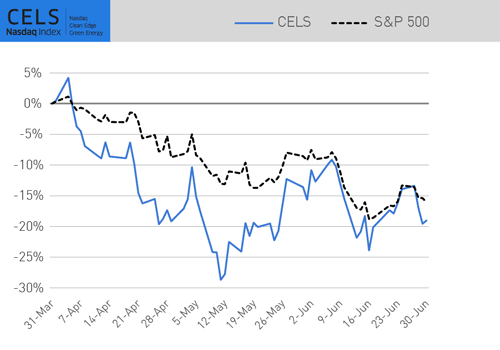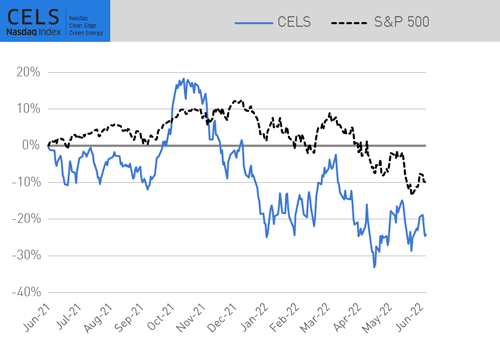By: Ron Pernick

Quarterly overview of stock index performance and the top trends impacting the state of clean tech.
Russia’s attack on Ukraine continued to roil global energy and food markets during the second quarter of 2022. Indeed, we saw two very different versions of the future emerging in the West: the super-charged adoption of renewables, electrification, and storage vs. securing as much non-Russian gas as possible with the buildout of new gas storage and LNG infrastructure. As we write this commentary, the EU just made the decision to include some natural gas and nuclear as “green” options in their EU taxonomy framework (we expect legal challenges to this European Parliament vote). The move is clearly out of step with climate science as well as public and investor sentiment, and it is sure to complicate concerns over greenwashing. Clean Edge does not consider natural gas a green energy option, but it’s important to remember that the energy transition from heavy carbon emission sources (coal and wood) to zero carbon sources (solar, wind, storage), was always reliant on natural gas as a bridge. In other words, it’s always been a both/and equation. But knee-jerk decisions made now will dramatically impact future ongoing investments in fossil fuels.
With this in mind, we offer up a 7-Point Energy Transition Action Plan (see Quarterly Insight below). Pulling together the collective knowledge of the Clean Edge team, we hope this plan provides both grounded insights and actionable steps in the pursuit of a cleaner and more resilient economy.
The EU decision notwithstanding, the unprecedented Russian attack on Ukraine is furthering the energy transition in many ways. Higher fossil fuel energy costs, for example, are likely to speed up the cost-competitiveness and availability of energy storage, EVs, renewables, heat pumps, and other clean-energy technologies (see the second annual Clean Edge Tech Maturation Model below). As we've highlighted before, between 2017 and 2021, the Nasdaq Clean Edge Green Energy Total Return (CEXX) beat out the Energy Select Sector Total Return (IXETR) in four out of five years. We take the mid- to long-term view that the energy transition is both necessary and inevitable – and increasingly the most economic option.
Against this backdrop, during Q2, CELS (U.S. clean energy) and QGRD (global smart grid & grid infrastructure) declined 19.02% and 17.18% respectively. HHO (U.S. water) and GWE (global wind) declined 14.16% and 12.82% respectively, both outperforming the S&P 500’s decline of 16.10% during the quarter. During the same timeframe, IXE (Energy Select) was down 5.26%.
Q2 2022 Index Performance (Total Return)
As of June 30, 2022 (Total Return) | CELS (U.S. Clean Energy) | GWE (Global Wind) | HHO (U.S. Water) | QGRD (Global Grid) | S&P 500 | IXE (Energy Select) |
|---|---|---|---|---|---|---|
Q2 | -19.02% | -12.82% | -14.16% | -17.18% | -16.10% | -5.26% |
YTD | -22.98% | -14.59% | -23.50% | -23.60% | -19.96% | 31.76% |
12-Month | -24.15% | -18.23% | -12.30% | -14.72% | -10.62% | 39.21% |
Year to date (YTD), the only Nasdaq-Clean Edge index to outperform the S&P 500’s 19.96% decline was GWE, which was down 14.59%. QGRD declined 23.60%, HHO was down 23.50%, followed by CELS which declined 22.98%. YTD IXE continued to have a strong showing up 31.76%. All results are on a total return basis.
YTD Index Performance (Total Return Through June 30, 2022)
Over the past 12 months (total return basis through the end of June), CELS declined 24.15%, followed by GWE, QGRD, and HHO down 18.23%, 14.72% and 12.30% respectively, compared to the S&P 500’s 10.62% decrease and IXE’s 39.21% increase.
12-Month Index Performance (Total Return Through June 30, 2022)
Financial products tracking Nasdaq Clean Edge indexes equaled more than $4 billion in assets under management as of July 2022.
DATA DIVE: THE CLEAN EDGE TECH MATURATION MODEL
In our first annual update to the Clean Edge Tech Maturation Model, we drew on our team’s decades of collective industry experience to analyze 40 clean energy technologies (adding 10 additional technologies to last year’s version). This model can be used by investors, governments, and other stakeholders to assess the market availability and cost competitiveness of these technologies over the next 10 years.

Technologies at the top right of the chart (e.g., utility-scale solar PV, onshore wind, and level 1-2 EV fast chargers) are widely available and cost-competitive with their established counterparts now or in the next 1-3 years, while those at the bottom left are 7-10+ years from maturity in our view. In future model updates, we expect less established technologies (such as green hydrogen, solid-state batteries, and bidirectional grids) to gain traction, becoming more widespread and moving toward technological maturity. We welcome your feedback on this year’s model, which we plan to update annually.
WINNERS AND LOSERS (INDEX CONSTITUENTS RANKED BY PRICE RETURN)
Below is a list of the top 10 best and worst constituent performers across Nasdaq Clean Edge indexes (CELS, QGRD, HHO, and GWE) during Q2 2022.
Best and Worst Constituents (Q2 2022)
Winners | Losers | ||
|---|---|---|---|
Daqo New Energy Corp. | 72.75% | Eos Energy Enterprises, Inc. | -71.05% |
JinkoSolar Holding Co., Ltd. | 43.26% | Romeo Power, Inc. | -69.87% |
BYD Co. Ltd. | 39.19% | Microvast, Inc. | -66.87% |
Xinjiang Goldwind Science & Technology Co., Ltd. | 24.83% | Navitas Semiconductor Corp. | -62.45% |
PNE AG | 19.68% | Volta, Inc. | -57.38% |
XPeng, Inc. | 15.04% | EVgo, Inc. | -53.27% |
Digi International, Inc. | 12.55% | Nordex SE | -51.46% |
International Business Machines Corp. | 8.59% | Lion Electric Co. | -49.88% |
Toray Industries, Inc. | 8.02% | Workhorse Group, Inc. | -48.00% |
Siemens Gamesa Renewable Energy S.A. | 6.09% | Ballard Power Systems, Inc. | -45.88% |
QUARTERLY INSIGHT: 7-POINT ENERGY TRANSITION ACTION PLAN
We estimate that the world is approximately halfway through the modern energy transition (2000—2050). If companies, governments, and individuals are going to meet their net-zero and carbon-reduction targets by mid-century, then how and where we focus our collective actions will matter. Targeted technology, policy, and capital innovations must be deployed at scale to meet the challenges of this monumental shift. We offer up Clean Edge’s 7-Point Energy Transition Action Plan as one possible pathway to ensure the viability and success of the clean-energy transition.
1) FOCUS ON EFFICIENCY FIRST
Pursue energy efficiency’s low-hanging fruit for the most bang-for-your-buck, including LEDs, insulation materials, building controls, and energy management systems.
2) SCALE UP WIND & SOLAR MASSIVELY
Support aggressive global deployment of solar and wind power, utility-scale and distributed, to reach 100% zero-carbon emission electric grids.
3) PAIR RENEWABLES WITH STORAGE AT SCALE
Deploy storage at scale to enable 100%, 24/7 renewable power. Focus on both utility-scale and distributed storage, using electrochemical batteries (lithium-ion, solid-state, flow, etc.) and mechanical energy storage (pumped hydro, compressed air, etc.).
4) ELECTRIFY HEATING & VEHICLES ASAP
Although we often hear the demand to “electrify everything,” we recommend focusing on two high-impact areas: passenger vehicles (two-, three-, and four-wheelers) and heating and cooling systems for homes and buildings (via adoption of electric heat pumps).
5) MODERNIZE TRANSMISSION & DISTRIBUTION GRIDS
Build out a range of electricity grid modernization efforts including digitization, smart meters and devices, bi-directional meters and charging, smart substations, and high-voltage, direct-current transmission lines. A modern 21st century grid is critical to enable the clean-energy transition.
6) DEVELOP GREEN HYDROGEN, AMMONIA, AND FUELS FOR AGRICULTURE, HEAVY INDUSTRY, AND LONG-HAUL TRANSPORT
Decarbonizing heavy industry will not be easy and will require green fuels above and beyond electrification. We recommend the adoption of green hydrogen and fuels to support the production of steel, fertilizer, and other energy-intensive industries, as well as for long-haul transport such as trucking, marine shipping, and air travel.
7) SECURE SUSTAINABLY MINED AND RECYCLED MATERIALS
Ensure the availability of mined and recycled materials for EV, solar, wind, and other clean-energy technology production. The future of energy depends on secure and reliable supplies of sustainably mined or recycled materials (lithium, rare earths, silicon, nickel, etc.) rather than the extraction of fossil fuels (coal, oil, gas).

Disclaimer:
The information contained above is provided for informational and educational purposes only. Clean Edge is not an investment adviser, and none of the information, including any Nasdaq Clean Edge index, should be construed as investment advice or relied on as the basis for making any kind of investment decision. Neither Clean Edge nor any of its affiliates makes any recommendation whatsoever to buy or sell any securities, fund, or financial product or any representation about the financial condition of any company, fund, or financial product. Information regarding any Clean Edge index is not a guarantee of future performance. Actual results may differ materially from those expressed or implied. Past performance is not indicative of future results and should never be relied upon for making any kind of investment decisions. Investors should undertake their own due diligence and carefully evaluate companies before investing. ADVICE FROM A SECURITIES PROFESSIONAL IS STRONGLY ADVISED.

